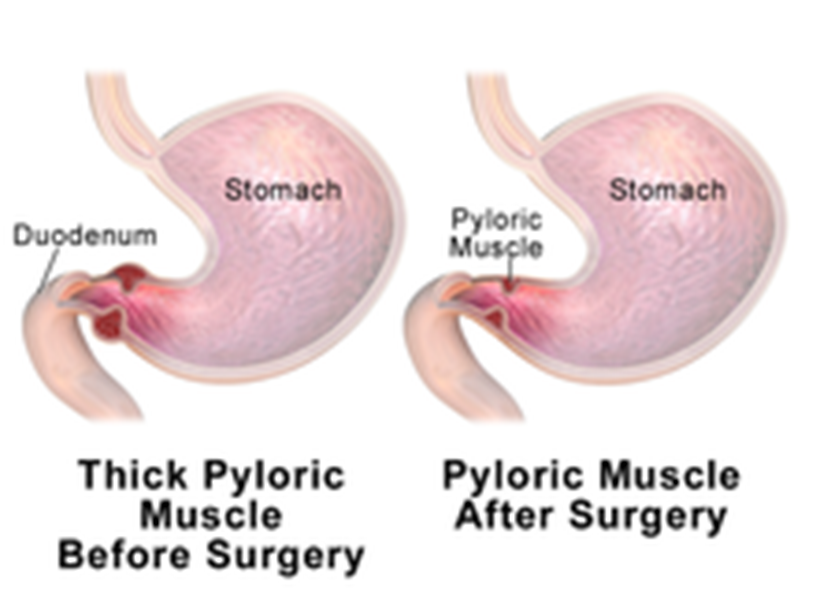A 6-week-old infant with poor weight gain is scheduled for a pyloromyotomy. Which pre-operative nursing action has the highest priority?
Mark an outline of the "olive-shaped" mass in the right epigastric area.
Maintain a continuous infusion of IV fluids per prescription.
Monitor amount of intake and infant's response to feedings.
Instruct parents regarding care of the incisional area.
The Correct Answer is B
Choice A reason: Marking an outline of the "olive-shaped" mass in the right epigastric area is not a priority nursing action. The mass is caused by hypertrophy of the pyloric sphincter, which obstructs gastric emptying and causes projectile vomiting. The mass may not be palpable in all cases.
Choice B reason: This is the correct answer because maintaining a continuous infusion of IV fluids per prescription is essential to prevent dehydration and electrolyte imbalance in the infant. The infant may have significant fluid loss due to vomiting and poor intake.

Choice C reason: Monitoring amount of intake and infant's response to feedings is important, but not the highest priority. The infant may have difficulty feeding due to nausea, vomiting, and abdominal pain.
Choice D reason: Instructing parents regarding care of the incisional area is a post-operative nursing action, not a pre-operative one. The parents will need to learn how to keep the incision clean and dry, monitor for signs of infection, and administer pain medication as prescribed.
Nursing Test Bank
Naxlex Comprehensive Predictor Exams
Related Questions
Correct Answer is B
Explanation
Choice A reason: Replacing the IV catheter with a smaller gauge is not an intervention that the nurse should implement, as this does not address the problem of the client picking at the dressing and tape. This is a distractor choice.
Choice B reason: Applying soft bilateral wrist restraints is an intervention that the nurse should implement, as this can prevent the client from harming themselves or dislodging the dressing and IV line. This is a last resort measure that requires a physician's order and close monitoring. Therefore, this is the correct choice.
Choice C reason: Leaving the light on in the room at night is not an intervention that the nurse should implement, as this can disturb the client's sleep and worsen their confusion. This is another distractor choice.
Choice D reason: Redressing the abdominal incision is not an intervention that the nurse should implement, as this does not prevent the client from picking at it again. This is another distractor choice.
Correct Answer is A
Explanation
Choice A reason: Moderate amount of foul-smelling lochia. This is the most indicative finding of a postpartum infection, as it suggests that the client has endometritis, which is an inflammation of the uterine lining. Endometritis is a common cause of maternal morbidity and mortality, and requires prompt antibiotic treatment.
Choice B reason: Blood pressure of 122/74 mm Hg. This is a normal blood pressure for a postpartum client, and does not indicate an infection. The reference range for blood pressure is 90/60 to 140/90 mm Hg.
Choice C reason: Oral temperature of 100.2°F (37.9°C). This is a slightly elevated temperature for a postpartum client, but it does not necessarily indicate an infection. The reference range for oral temperature is 97.6 to 99.6°F (36.4 to 37.6°C). A mild fever may occur in the first 24 hours after delivery due to dehydration or hormonal changes.
Choice D reason: White blood cell count of 19,000/mm³ (19 x 10⁹/L). This is a high white blood cell count for a postpartum client, but it does not indicate an infection. The reference range for white blood cell count is 5,000 to 10,000/mm³ (5 to 10 x 10⁹/L). A leukocytosis may occur in the first few days after delivery due to stress or tissue injury.
Whether you are a student looking to ace your exams or a practicing nurse seeking to enhance your expertise , our nursing education contents will empower you with the confidence and competence to make a difference in the lives of patients and become a respected leader in the healthcare field.
Visit Naxlex, invest in your future and unlock endless possibilities with our unparalleled nursing education contents today
Report Wrong Answer on the Current Question
Do you disagree with the answer? If yes, what is your expected answer? Explain.
Kindly be descriptive with the issue you are facing.
